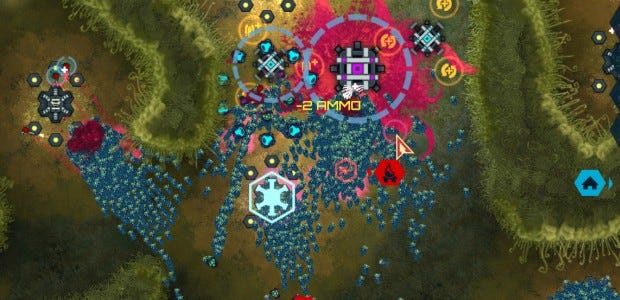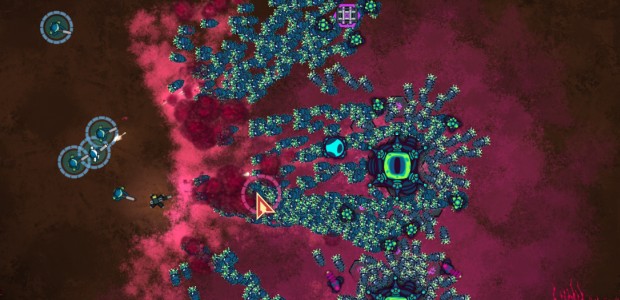How Do Infested Planet's Mutations Work?
The Mechanic
This is The Mechanic, where Alex Wiltshire invites a developer to help him put their game up on blocks and take a wrench to hack out its best feature, just to see how it works. It’s about the sweat, grease and genius behind the little things that make games special.
Infested Planet [official site] is an RTS that channels Starship Troopers. You control a small squad of soldiers fighting their way through caverns of hives that endlessly churn out insectoid bugs. The body count reaches tens of thousands as you capture the hives, steadily gaining and conceding ground to make best use of your limited resources. It’s an intensely dynamic game of observing and controlling flows of bugs and continually respec-ing your forces, because you’re always up against:
THE MECHANIC: Mutation
Singleplayer strategy games are struck through with a weird tension. You start out getting to know their big boxes of tools, understanding their strengths and weaknesses through experimentation, trying out this against that and searching for optimal solutions. This is the sweet spot, where you’re partly anxious because it feels like you’re always on the back foot, but you’re also enthralled because you’re coming up with new plays and being rewarded with success and chided by failure.
But when you find those solutions, experimentation withers as you start to use them over and over. Falling back to what you already know means you’re probably not making interesting decisions any more, and at a deep level the game kinda stops being fun. You’ve stopped learning, and levels become rote exercises in performing a routine to get to the goal.
Designers know this, of course, and the typical response is gimmickry. In games like StarCraft II it’s cool gimmickry, I’ll stress, where levels are often one-off scenarios that equip you with specific tools, handicaps and enemies which force you to explore new strategies. That makes the singleplayer levels in SCII super fun, and also, once played, not really worth returning to.
Infested Planet goes about it differently. Instead of pre-determined situations, it has a feature called mutation, which dynamically changes the composition and abilities of the enemy in order to counter and disrupt yours. It feels fresh and challenging, and it’s also part of a general movement in games where they’re becoming more responsive to player strategy, such as the way delivering headshots in Metal Gear Solid V eventually prompts the enemy to start wearing helmets, and that enemies will start shooting down Gargoyles in the Arkham Batman games if you use them a lot.
In Infested Planet, mutations, which generally trigger when you destroy an enemy hive, might introduce new unit types or effects. So, you might have equipped a couple of your soldiers with flamers, which are short-range, wide-angled weapons that are massively effective against standard bugs, knocking them back and dealing high damage. But then the bugs might get the mutation Bombardment, which increases the range of their towers, or Impact, which adds knockback to hits from towers, or Neurotoxins, which make tower hits slow your soldiers. Your flamers suddenly can’t close range on hives, and you’ll need to retool and rethink, fast.
Infested Planet’s mutation amounts to a lightspeed and in-game version of StarCraft’s metagame, in which you are always having to react and reconstruct your approach in accordance with what’s being flung at you. You can’t settle on a single strategy, not even during one level, because sooner or later the game is going to deftly undercut you. Designer Alex Vostrov puts it like this: “I know you love minigunners, but try something else. There’s another solution here.”
The entire game is founded on this precept. Vostrov was subconsciously inspired by Red Alert 2 and the patterns of singleplayer RTS design that had been laid down by Dune 2. “What does the opponent do? Sends little trickles of attack squadrons, right? It’s very pronounced in Westwood Games, where it wouldn’t really play against you. Scenarios were set up where it had gigantic bases; if it was a player it’d be able to crush you. So it’d send out trickles of units, and that’s what bugged me, and what started me off.”
Because mutation faces you with shifting challenges, you need to be able to shift your forces, too, something Infested Planet addresses through a novel approach to resources. “A lot of Infested Planet can be just read as things that frustrated me about modern RTSes,” says Vostrov, this time bugged by the way you can generally win them. Because the AI doesn’t rush you, a fine strategy is to mine resources out, build a massive army, and sweep the map. “Any challenge can be met by waiting another 10 minutes. Which kind of sucks.”
In contrast, Infested Planet awards resources in proportion to your captured hives, but once gained they sit in a reusable pool. You can buy a sniper and then change it into shotgunner, or build a turret and later sell it for its full value. A good player (someone who is not me) constantly shifts roles – going scout to move quickly across the map, before switching to shotguns and snipers on arrival.
You’d expect that mutations are controlled by a system that watches your performance, and you’d be right, but only on the highest random skirmish difficulty (Terminus) and in the last mission. That’s because it’s really hard to play against.
For the rest of the time, enemy mutations are actually just random. But it doesn’t feel like that at all. Every mutation feels like a direct result of your tactics. Vostrov wasn’t expecting this – he merely wanted to know mutation was actually fun before he invested the time in creating an AI system to manage it (“I’m a lazy designer and programming these things is hard”). But it worked. “From a designer’s point of view, what’s the point of complicating things, unless you’re doing it to serve the player?”
But he wanted a special final level, so right at the end of the game’s development, he created that system. Vostrov shows me a debug overlay listing numerical weightings to certain stats and spawns some miniguns. The ST_MU_MINIGUN value starts to steadily tick upwards, and as it does so, values for certain mutations start to rise, too. Soon, Clone Strike reaches the top. It’s an effective response to powerful minigunners because it spawns clones of your own squad against you, gaining your power. The game knows this is effective, because it’s loaded with tables comparing weighting patterns to effective counterstrategies.
The steady nature of the weighting system means it’s measuring your performance over periods, so if you’re nimble enough, you could feint by sticking with one set of weapons, then quickly attack with another before it can mutate its counter. Still, it’d be plenty strong enough to raise some horrible mutation combinations against you if it wasn’t held back by mutations having point values so, as Vostrov says, “it can’t pig out on the really powerful ones.”
It’s still too hard for inexperienced players, though. Vostrov made Infested Planet more or less alone and he did most playtesting himself. “Which was probably a mistake,” he says. “The problem with designing the core system yourself is that you know the game perfectly, so you don’t have the confusion factor.” He’d add a mutation or weapon and constantly ask questions: When would he use it? When would it be the worst choice? Is it too good? Are there not enough things countering it? “They would gnaw at me internally: ‘Aaagh, it’s too good!’”
The results don’t show that pressure. In fact, the asymmetric nature of the game – your few against thousands – covers most rough edges. It’s a hard game, but more than worth persevering with. After all, it’s rare to play a game that responds so intimately to your actions.











